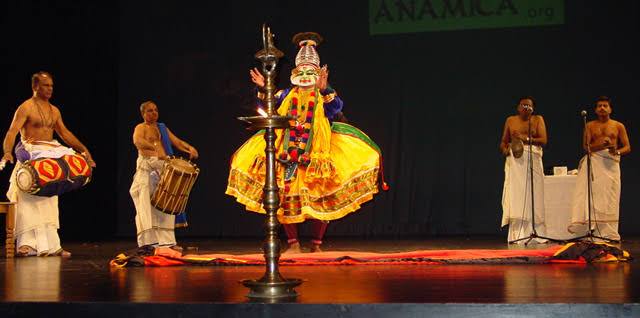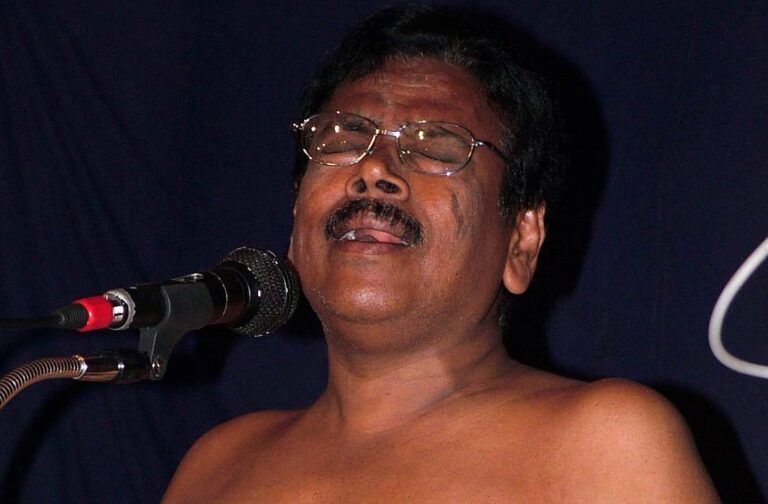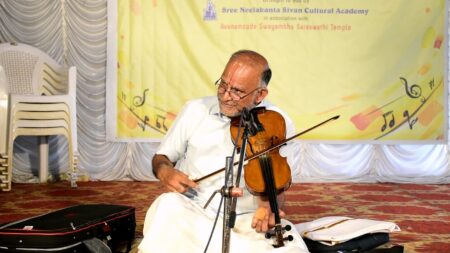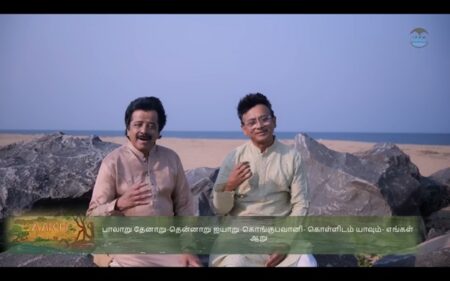With a sharp sense of sruti and strong grip on rhythm, Kalamandalam Hyderali broke many barriers not only to become an eminent Kathakali musician but also to emerge as a symbol of secularism. Today is his 75th birthday.
On a fine morning in April 1957, an eleven-year-old Muslim boy with an emaciated body stood trembling in the portals of Kerala Kalamandalam campus on the banks of the Nila River. Standing before a team of scholars that included Poet Vallathol, Mukunda Raja and Neelakantan Nambissan, the boy rendered quite evocatively the film song Kanne kaniville from Rarichan Enna Pouran. The mood of supplication evocatively delineated, flawless sruti and precision of rhythm impressed the interviewers. And the young Hyderali from Ottupara, near Wadakkanchery, was declared selected for the Kathakali Sangeetham course.
Admission of a Muslim boy into the premier institution of classical performing arts that too with the timely help from a Christian – C P Antony, a social worker from Ottupara who had executed the bond for Rs 2000, as required by the formalities – marked the advent of secularism in Kalamandalam. But eight years of rigorous disciplining under the doyens Neelakantan Nambissan and N K Vasudevan Panicker produced one of the most outstanding Kathakali playback singers of our times, Kalamandalam Hyderali.
Grooming under veterans
The history of Kathakali sangeetham can be summed up as the history of its varied styles. From the amorphous one of the pre-Venkitakrishna Bhagavathar period, through Neelakantan Nambissan and his disciples, one can see the evolution of individual styles, thanks to the contributions of Unnikrishna Kurup, Kalamandalam Gangadharan, Embranthiri and Hyderali – all products of Kalamandalam.
Still, it is surprising how the relatively subservient department of the classical dance-theatre has been instrumental in attracting quite a sizable number of new-generation connoisseurs to the art form, notwithstanding the flak it continues to attract from critics even today.

An acute sense of sruti, astounding grasp of the nuances of music, strong awareness of the variegated rhythm patterns that the applied music demands, an unusual penchant for the niceties for all the genres of music – these are some of the features that portray Kalamandalam Hyderali, the musician. His modulations are specially noted for the absence of deliberate inflections of voice, a characteristic of Kathakali musicians. The refined enunciation captures the imagination of the listeners the very moment he begins the rendition.
“If Kathakali is a classical art, its music also has got to be classical, but only to the extent of supplementing abhinaya”, believed Hyderali whose eloquence waxed whenever the excessive influence of Carnatic music was brought to his notice.
Incidentally, he belonged to that rare genre of musicians in the country who are not averse to discussing music.
Presenting a paper on Kathakali Sangeetham in a seminar organised jointly by the Central Ministry of Culture and K N Pisharody Smaraka Kathakali Club at Irinjalakuda long back, he explained “mixing of ragas and a departure from the ones prescribed by the playwright have been very often inevitable for embellishment reasons”. And he substantiated his argument by citing the example of the padam, “Parthalathil keerthiyulla parthanmmare” in which the slight deviation from the prescribed raga Goulipanth has been successfully employed to suit the character of aasaari (carpenter) in Bakavadham. Apart from the ragas, the tempo of the rhythms is equally vital in the creation of mood, he had pointed out. “But it is a pity that no one cares about the flaws in percussion during the performance; it is the only music that comes under fire”, he used to complain.
A musician who broke the barriers
Hyderali can remember only with awe his affectionate guru Nambissan for whom he was simply “Hyder”. An accomplished teacher, Nambissan never brooked mistakes. On the eve of Hyderali’s debut along with Sankaran Embranthiri as sinkidi, Nambissan dealt a heavy blow on his left cheek as the budding musician’s padam “nava bhava dasokadala” felt short of a beat of Chamba in extremely slow tempo. Even though the hearing ability of the left ear could be retrieved only through vigorous treatment extending to a month, Hyderali kept it a closely guarded secret! He used to say with a sense of gratitude, “But for Nambissanassan and M K K Nair who took him under his wings in FACT on the recommendation of the former, I would not have become what I am today”.
Manjuthara and Orthaal Visamayam, the books authoured by him give a vibrant picture of his life and its vicissitudes, especially being the only non-Hindu to learn an art form that banks on stories excerpted from Hindu puranas and scriptures. But Kathakali aficionados thronged the venues where he performed. They recall how those in control of an ancient temple in Haripad had actually pulled down a part of the compound wall and extended the platform for Hyderali to sing without entering the precincts of the temple.
Hyderali was fond of driving. Once he dropped in my home during the wee hours. I guessed something had gone wrong. But that was for presenting me with his book. And I asked him, “why this time? He said he was returning after a play in Alappuzha or so. I advised him not to drive after long hours of performance in the night.
I remembered his visit when the news was broken by the media on January 5, 2006, about his death in a road accident at Mullurkkara near his hometown as he was on his way to Kalamandalam for teaching. Had he been alive, he would have completed 75 years today.





1 Comment
A befitting tribute to the great musical genius.